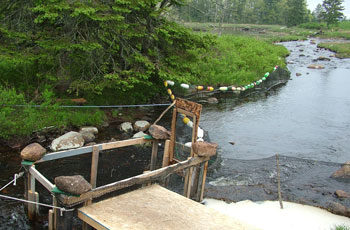Alewives to Benefit from Dam Removal
by Fishernmen’s Voice Staff

Alewives are seasonally harvested by varied means. Regulations limit harvesting to three days a week in the season. Harvesters often voluntarily do the alewife restoration work opening blocked streams or carrying alewives over dammed rivers and streams to the lakes beyond. Fishermen's Voice Photo
The Maine legislature passed a bill in April which will open the St. Croix River for the unimpeded passage of alewives and blueback herring both generally referred to as river herring. Jeff Pierce of the Maine Alewife Harvestors Association said their association and others have been working to reopen the St. Croix River, largest spawning area for alewives in the state of Maine, since 2005.
The Passamaquoddy tribal governor had filed an emergency action with the state seeking to open the Woodland Dam and the Grand Falls Dam to unimpeded passage. The bill that passed will allow for the removal of the Woodland and Grand Falls dams on the St. Croix. It will also enable unimpeded passage at the Vanceboro dam on the Canadian side of the border.
With federal pressure to close alewife fisheries along the east coast unless states can show they are being sustainably managed Maine needed to act. Only Maine and South Carolina have active commercial alewife harvests. With the dams open the numbers of alewives and increased access Maine will have a chance of gaining sustainable management status. If the fishery is closed it could remain so indefinitely. Since the resource has been restored and maintained privately, forced closure would mean an end to that management oversight. Federal agencies are believed to be without funding for alewife restoration projects.
A source of resistance to opening the dams to alewives came from recreational fishing guides in the region around Grand Lake Stream in eastern Washington County. They thought the alewives would threaten the non-native brown trout above the dams where waters had been stocked with brown trout. Sport fishermen came to commercial camps to fish for brown trout.
In the 1990’s camp owners and guides lobbied to close the fishways that allowed alewives past the dams.
Pierce said these non-native species were in fact more likely to prey on the native alewives which will now be able to swim up stream in the spring to spawn.
The vast network of streams and lakes in the St. Croix River system have produced millions of alewives for thousands of years. The dams have resulted in alewife declines that are now seen to be undermining the restoration of cod stocks and other fish in the Gulf of Maine that feed on them.
“Maine is considered the gold standard in alewife restoration”, said Pierce. The restoration in Maine has been privately funded. Research and data collection such as scale sampling has been done with private funds. “The Department of Marine Resources (DMR) has been a great partner”, said Pierce. “Pat Keliher was in charge of sea run habitat before becoming DMR Commissioner. Many of the major restorations have been led by the DMR”, Pierce said.
The alewife harvestors and the others who have worked to restore habitat are now looking forward to opening more habitat and unimpeded passage for alewives in other parts of Maine.
Pierce said. “We have good clean water in Maine. With more alewives and blue backs spawning in more waterways there will be more cod, haddock, silver hake and Pollock in the Gulf of Maine.
